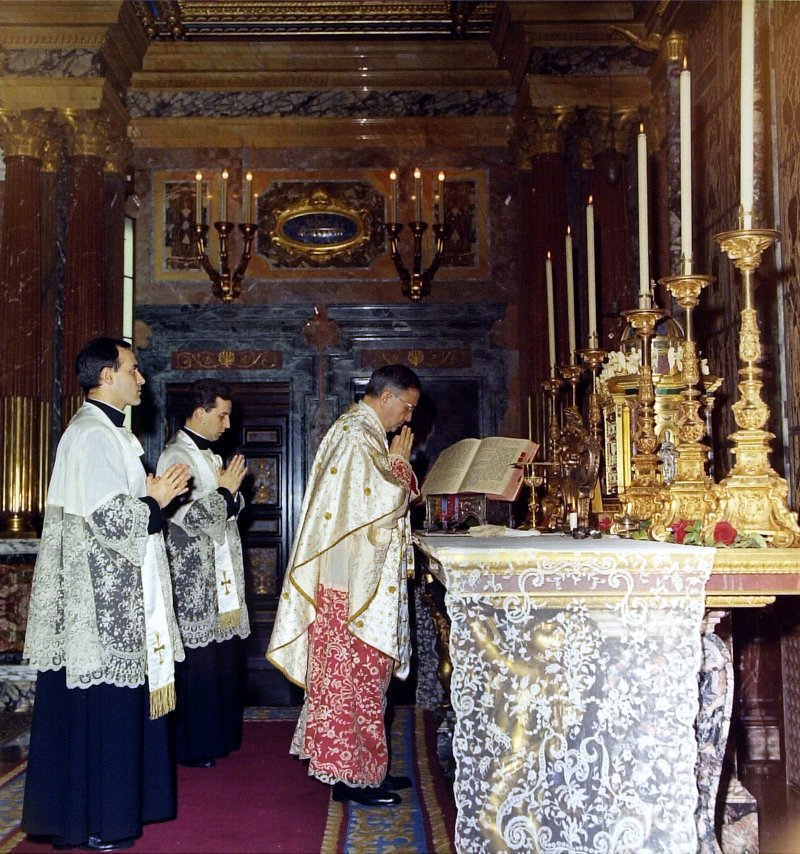This saint, after 1969, never said Mass using the Novus Ordo
Summorum Pontificum was a tremendous gift to the whole Church. It was certainly one of the most – if not the most – important achievements of Benedict XVI, part of what I cal his Marshall Plan. It is a great tool of the potential revitalization of Catholic identity which is so desperately needed.
At NLM Peter Kwasniewski reminds us about something important.
St. Josemaría Escrivá (1902-1975), the founder of Opus Dei, celebrated the traditional Latin Mass all his life as a priest. He had mystical experiences in connection with it. He loved it so much that he obtained permission (it was thought at the time that such permission was necessary) to continue with the Mass he had always offered, rather than shifting over to the Novus Ordo Missae. These are facts that deserve to be better known.[1] A marvelous gallery of photos of the saint celebrating the usus antiquior may be found here.
The footnote says: There are, as one might expect, different stories circulating around about what exactly happened after 1969, some of them more colorful than others. This is a fairly sober account, although its title is oddly anachronistic: “Why St. Josemaría Escrivá Only Celebrated the Extraordinary Form.”

It is possible that some of you newer readers here haven’t yet seen my Marshall Plan reference.
I have argued that Summorum Pontificum, the centerpiece of Benedict XVI’s “Marshall Plan” (my image) for the Church, is one of our greatest tools for a true revitalization of the Church and Catholic identity.
After World War II these United States rebuilt war-ravaged Europe for humanitarian reasons, but also to help create trading partners and a prosperous bulwark against Communism.
After Vatican II, many spheres of the Church were devastated, ravaged by internal dissent, a loss of continuity with our tradition, and from erosion by the secularism and relativism of the prevailing modern world.
We need a Marshall Plan for the Church in the modern world. Certainly what we have been doing up to this point isn’t producing fantastic results across the board. That’s because we don’t seem to know who we are anymore.
Joseph Card. Ratzinger had been concerned for years about the loss of Christian identity, which is at the heart of Western Civilization. Later, as Benedict XVI, he gave us a great tool by which we could reinvigorate our Catholic identity and, so, resist the negative influences of secularism and relativism.
I think that Benedict intended Summorum Pontificum to play a key part in a long-term strategy to rebuilt our Catholic identity, to correct our way of reading … well… just about everything over the last half century or so, and to establish a strong defense against the dictatorship of relativism.
Only with a solid identity can we, as Catholics, have something positive and healthy to offer to the world at large, a clear voice offering important contributions in the public square. Look, for example, at the clarity and courage of the Little Sisters of the Poor against the evil machinations of the Obama Administration. They have a clear identity and they are steadfast. As a result they provide an inspiring example and they keep certain values before the public eye.
Our identity as Catholics is inextricably bound together with the way we pray as a Church.
To give shape and strength to our Catholic identity in these difficult times, we need an authentic liturgical renewal, a renewal that reintegrates us with our tradition, brings us into continuity with the deep roots of our Catholic Christian experience of two millennia.
Contrary to the notions of most progressivists, “the Catholic thing” did not begin in the 1960s.
There can be no authentic change for a better future without continuity with our past.
Liturgy is the tip of the spear.
Benedict XVI pointed us toward a healthier vision of the Church’s doctrine, history, public worship and our very identity as Catholics.
Just as a return to, for example, reading the Fathers of the Church can help us, collectively, correct the way we have been reading Scripture, so much and too long under the domination of an over-played historical-critical method, so too the Extraordinary Form can help us learn how to worship God as a Church which is not fragmented into tiny shards, and to reorient ourselves away from ourselves.
No positive initiative that we undertake in the Church will succeed unless it is rooted in and oriented by a revitalized sacred liturgical worship of God. Everything comes from worship and everything goes back to worship in a dynamic, ongoing commercium.
Start your local movement for the implementation of Summorum Pontificum NOW. I don’t think we have a lot of time to waste.
¡Hagan lío!
